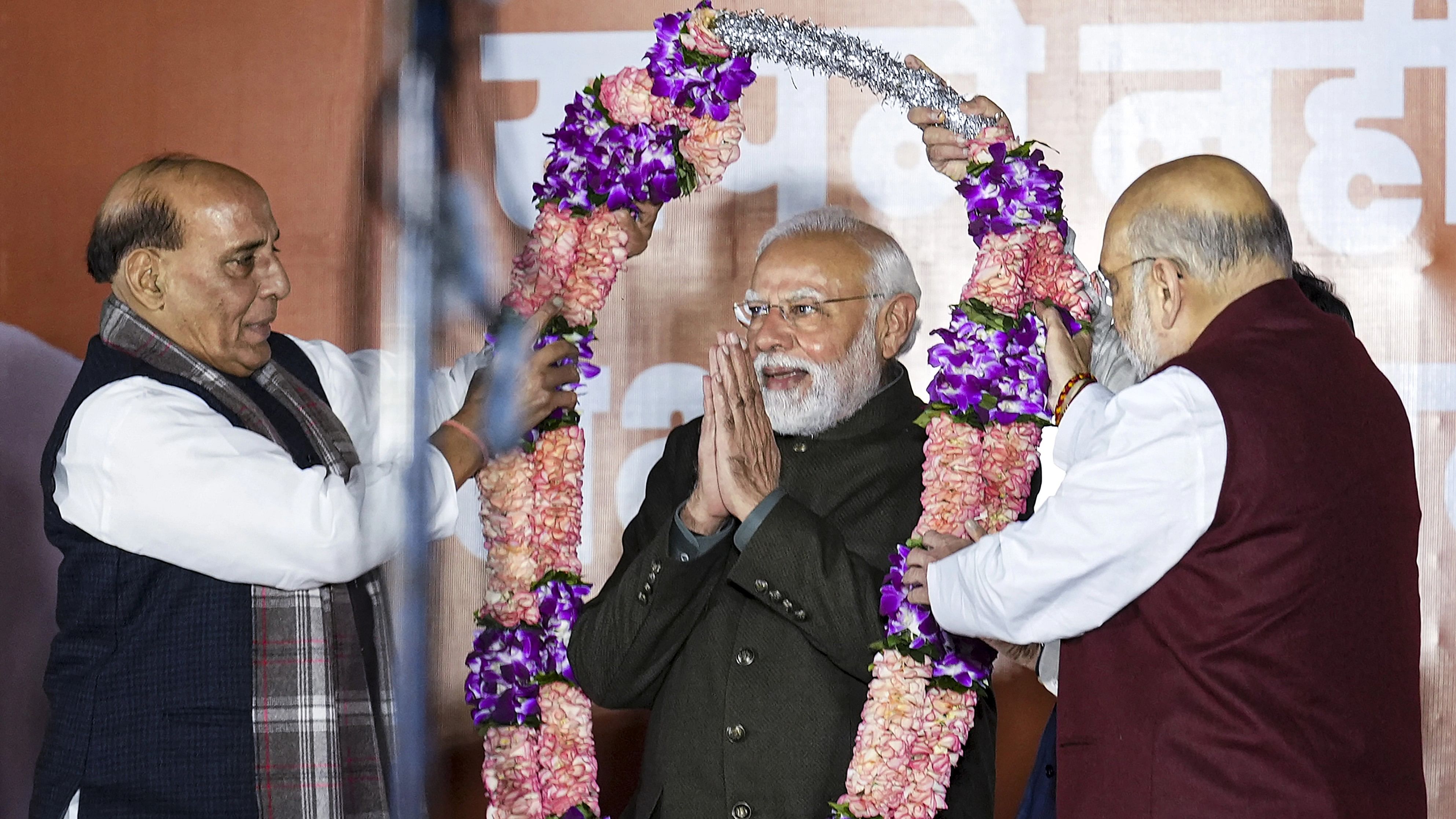
Prime Minister and senior BJP leader Narendra Modi with Defence Minister Rajnath Singh and Union Home Minister Amit Shah during celebrations after the party's victory in elections to the Legislative Assemblies of Madhya Pradesh, Rajasthan and Chhattisgarh, at BJP headquarters, in New Delhi.
Credit: PTI Photo
The BJP’s clean sweep in Madhya Pradesh, Rajasthan and Chhattisgarh consolidates the ruling party’s pole position ahead of the Lok Sabha polls next year while exposing Congress’ limitations in taking on the Narendra Modi-led BJP in a one-on-one contest in the heartland states.
The Rajasthan results are on expected lines, but the turnaround scripted in MP and Chhattisgarh are spectacular, both in terms of scale and vote differences.
If one were to analyse the poll outcome in totality, a common thread runs through the three states comprising a vast swathe of the Hindi-speaking belt stretching from Bastar to Barmer — it has fallen into a saffron spell.
Both the BJP and Congress competed with their versions of welfarism, trying to outdo one another by offering freebies. But Congress’ inability to erect a credible ideological bulwark remains a gaping hole in its strategy, which has to compete against the BJP’s double-engine-government bait, served with a heady mix of labarthi schemes and a dash of Hindutva.
From Kawardha in Chhattisgarh, which witnessed communal riots this year, to the Kanhaiya Lal case in Rajasthan’s Udaipur, the undertones of the BJP’s campaign remained firmly latched to its Hindutva agenda. Its impact on the narrative is clear on the election map that has been painted saffron by the BJP’s wave in central Chhattisgarh and south Rajasthan.
But wherever needed, the BJP was nimble enough to match the Congress’ aggressive welfarism. Having learned its lesson in Karnataka, the party was not averse to doling out freebies. Gauging the traction Shivraj Singh Chouhan’s ‘laadli behna’ scheme received in MP, the party announced its version of the dole for women in Chhattisgarh as well.
For the Congress, the ideological framework in these elections was articulated by Rahul Gandhi, who promised caste census and proportional representation in government jobs and educational institutions.
This should have worked in a state like Chhattisgarh with a substantial OBC population and a chief minister who came from the same community. It didn’t. Probably, because that’s a textbook Mandal narrative not associated with the Congress.
It’s too early to say whether the caste pitch cost the Congress a section of the upper caste vote. Or did the ‘sanatan dharma’ controversy triggered by its Dravidian ally, the DMK, add to its woes? What’s good for the goose is not necessarily good for the gander.
In all three states, the BJP did not name a CM candidate, and, in a new template, asked its sitting Lok Sabha MPs to contest in tough seats. The votes were sought in Modi’s name, but wherever required, the party was not averse to amending the script.
In MP, Chouhan’s candidature was not announced in the first three lists, but Modi in the last lap issued a written endorsement in the CM’s support. In Rajasthan, many of Vasundhara Raje’s supporters were accommodated in the last two lists, though she was not named the CM candidate. Despite having taken a position on ‘revari culture’, the BJP tried to match Ashok Gehlot’s welfare schemes.
The elections show that irrespective of the burden on the exchequer, competing welfarism and political populism are here to stay.
For the Congress, the only silver lining has been the Telangana victory. It now rules in two southern states and is in power with the DMK in Tamil Nadu. In the north, it has been limited to Himachal Pradesh.
The outcome of this round of Assembly polls will now weigh on the party’s efforts to negotiate its position within the I.N.D.I.A alliance. Will Nitish Kumar and Mamata Banerjee be on the same page on the issue of nationwide caste census?
In UP, Akhilesh Yadav has made no bones about his offer for a tie-up in MP. The Aam Aadmi Party would strike a hard bargain in Punjab and Delhi. A comeback in the next round of Assembly polls in Haryana and Maharashtra becomes tougher.